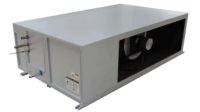LG won an Innovation Award at this year’s AHR Expo for its Hydro Kit, an indoor heat exchanger for LG VRF systems that is capable of transferring heat or cooling energy expelled from the air conditioning process to water, which further capitalizes on the efficiency of LG heat recovery and heat pump systems.
“We see a lot of move toward decarbonization and electrification,” said Chester Biggs, product manager and senior applications engineer for LG Air Conditioning Technologies.
The Hydro Kit is an indoor heat exchanger for LG VRF systems, capable of transferring heat or cooling energy expelled from the air conditioning process to water, which further capitalizes on the efficiency of the heat recovery and heat pump systems. The kits are available in 42,000 and 96,000 Btu/h capacities, providing homeowners energy efficiencies that were previously only available on larger commercial projects. Featuring outgoing water temperature ranges (41 to 77°F cooling, 68 to 122°F heating) and water flows (5.3 to 10.4 gpm for 42K and 8 to 24.3 gpm for 96K), the LG Hydro Kits are suitable for a number of residential applications.
LG Hydro Kits also include their own controllers, and operation can be controlled in a variety of ways, including temperature of the leaving water, hot water tank temperature, or the temperature of the conditioned space. The Hydro Kit also interfaces with a wide variety of field-provided thermostats and sensors.
ECOSYSTEM
Another key highlight for LG is the official debut of its Coil Communication Kit. The new kit allows for seamless connection of LG smart inverter condensing units to third-party coils. Designed for the replacement market, the Coil Communication Kit broadens access to the benefits of LG’s energy-efficient technologies by allowing connection to third party furnaces or air handling equipment for residential and light-commercial applications. This includes compatibility with common third-party thermostats and LG’s line of intuitive controls. It also offers smart set point tracking logic, factory-customized cased coils for minimal field work, and multi-position coils to fit a wide range of applications.
Also launching at AHR was the LG Console Indoor Unit, available in a 9,000 to 15,000 Btu/h capacity range. Designed for the markets where heating days outnumber cooling days, the console unit increases design flexibility for the types of spaces in which to apply LG’s energy-efficient technologies. Available for single- and multi-zone system configurations, this flexible new indoor solution is designed for rooms with gabled ceilings or sunrooms. This unit comes embedded with LG ThinQ® technology, allowing for connectivity to other smart LG home appliances.
At a press conference, Carl Barnard, director of controls sales at LG, described a house filled with LG products, from the solar panels on the roof to the appliance to the air conditioning. They would all be linked and work together to improve the comfort and efficiency of the occupants.
ROOFTOP REDESIGN
LG’s redesigned rooftop dedicated outdoor air systems (RT DOAS) offer building owners and facility managers the ability to implement a complete end-to-end LG HVAC system. Available in a wide range of capacities, LG RT DOAS units are available up to 70 tons and are configured to be easily compatible with LG VRF systems and LG MultiSite™ controls. The redesigned DOAS units allow for 100 percent outside air with heating, cooling, and dehumidification for accurate automatic conditioning and control of the outside air being supplied to the building.
Upgraded inverter scroll compressors enable accurate capacity control when operating below design conditions, allowing for even quieter operation and a significant reduction of energy costs. With increased energy efficiency, the new RT DOAS units exceed the proposed AHRI 920 standard for measuring DOAS moisture removal efficiency.
The LG AHU Conversion Kit allows for third party air handling units (AHUs) to integrate with any LG Multi V™ condensing unit, thereby maximizing the performance of the system and capitalizing on the efficiencies of LG VRF technology. This solution consists of the LG Electronic Expansion Value (EEV) Kit and the Communication Kit, allowing for streamlined integration of third-party AHUs with LG air source or water source VRF systems. This creates a solution for commercial applications where code requires a specific capacity, or a particular amount of outside air not currently offered by LG models, but the project team still wishes to maximize the efficiency of the system through the use of VRF condensing units to reduce operating costs.
See more articles from this issue here!




